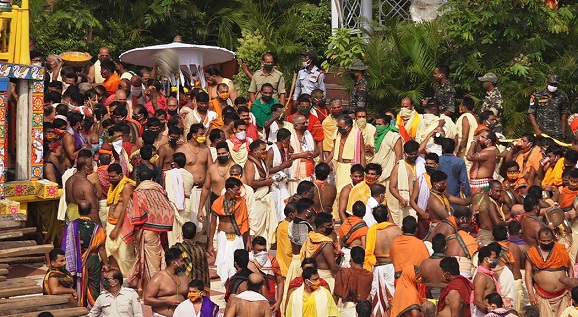The people who perform the ritual services at the Jagannath temple are called the sevayats or servitors. These sevayats acquire their position hereditarily. Records of 13th century A.D. and of the British period suggest that there were 36 categories of sevayats. Within the last two centuries the number of categories have been increased from 36 to 250.
The first sevayat of Lord Jagannath is Gajapati, the king of Puri. He as a sevayat is expected to perform certain duties and rituals 0n certain occasions. The major ritual is that he sweeps the three chariots of the lord with a golden broomstick. Courtesy: OmmComNews
Courtesy: OmmComNews
Earlier the head of the sevayats used to be the Rajaguru. Today Patjoshi Mohapatra is the head of all Servitors. He is entrusted with the functions of managing the pariccha. He ensures that the Servitors perform their duties properly and rites of temple are observed regularly.
Bhitara-Chhu Mohapatra looks after the sanctity of the Bhog being offered to the deities and also to the cleanliness of the temple premises. Taluchha Mohapatra likewise looks after the cleanliness of the kitchen. Mudirath performs all works of the King in latter’s absence as his representative. The temple Purohit chants Vedic Mantras and performs Japas. Pujapandas performs the ritualistic Puja (worship). Puspalaks dress up the deities, smear sandal wood paste etc. Khuntias guard the sacred body of the deities. The Mekaps remain in charge of different store articles. Pratiharis keep guard over different strategic points. Suars cook the food offerings. Karans keep the accounts of all expenditure both cash and materials. Bhitara Gaini Seva (service) is performed by the Debadasis who sing songs before the deities. The Daitas perform all duties during Snana Purnima and Ratha Yatra (Car Festival) and plays an important role during Nabakalebar, the ritual in connection with changing of wooden bodies of the deities. It is said that they are the decedents of the shabara chieftain Biswabasu, who was worshiping Jagannath before the Lord came to this temple and hence the Daitas are considered as close relatives of Jagannath.
Nearly 75 such sevayats perform their functions daily and without any salary. They are only entitled to get a portion of the total bhoga or offerings. This portion is known as ‘Khei’. A few sevayats also get cash rewards from the management. On special occasions like Rath Yatra, all the sevayats are given cash rewards.
Today, there are 119 categories of sevayats at the temple according to the Record of Rights of the temple. These categories are:
| 1.Gajapati Maharaja | 2. Parichha or Raj Guru | 3. Chhatisha Nijog Nayak (the head of the Servitors) – Pattajoshi Mohapatra |
4. Bhitarchha Mohapatra | 5. Talichha |
| 6.Mudrahasta or Mudirasta | 7. Deula Purohit | 8. Puja Panda | 9. Badapanda | 10. Pushpalaka |
| 11. Mahajana | 12. Mudra | 13. Khuntia | 14. Bhandara Mekapa | 15. Palia Mekapa |
| 16. Akhanda Mekapa | 17. Changada Mekapa | 18. Khataseja Mekapa | 19. Pratichari | 20. Daita |
| 21. Pati Mahapatra. | 22. Patribadu | 23. Garabadu | 24. Suarabadu | 25. Khurinayak |
| 26. Mukhapauhala | 27. Ghatuari | 28. Gochhikara | 29. Suna Goswami | 30. Muduli |
| 31. Alatibalita Sevaka | 32. Puranapanda | 33. Duttamahapatra | 34. Lugadhua and Pani Kunda Sevak | 35. Ballava Jojania |
| 36. Bimanabadu | 37. Anasara Sudasuara and Suda Suara | 38. Hadapanayak | 39. Bidia Jogania | 40. Khatuli Sevak |
| 41. Astana Pratihari | 42. Kothabhog Jogania | 43. Pradhani | 44. Paila | 45. Lenka |
| 46. Suaranijoga Nayak | 47. Suaranijoga and Mahaswara | 48. Jagia Mahasuara | 49. Badu Suara, thali, tuna and Amalu Suara | 50. Pantibadu |
| 51. Amalutola, Purakharadi | 52. Tolabadu | 53. Rosha Paika | 54. Baharadeuli Suara | 55. Baharadeuli Jogania |
| 56. Rosha Dhopakhalia, Angarua, Gobarapania and Rabadia | 57. Handi Jogania | 58. Birimunda Samartha | 59. Kothabhoga Pania | 60. Panikipata |
| 61. Nikapa and Gandhana Nikapa | 62. Biribuha | 63. Daudibala | 64. Churana | 65. Sabat Nijog |
| 66. Pania – pata | 67. Mandani | 68. Chakaapasara | 69. Mulia Suansia | 70. Binakara |
| 71. Darpania | 71. Kothasuansia | 73. Mahabhoi | 74. Gita Govinda | 75. Bhitara Gaini |
| 76. Sanpradanijog | 77. Dayanamali | 78. Madei | 79. Prasad badu, Badu Mohapatra | 80. Tatua |
| 81. Patara bandha | 82. Vijayanti | 83. Chhatara nijog i | 84. Kahalia | 85. Sankhua |
| 86. Parbajatra Jogania | 87. Chitrakara | 88. Rupakara | 89. Bania | 90. Tamara Bisoyi |
| 91. Karotia | 92. Bentabindha Paika | 93. Patara Bisoyi | 94. Kala Bethia | 95. Daraji |
| 96. Kumbhara Bisoyi | 97. Rathabhoi | 98. Malachula | 99. Banua | 100. Chakra dihud |
| 101. Ojha Maharana | 102. Ghanta Seva | 103. Gantua | 104. Ratha Dahuka | 105. Badhei |
| 106. Baidya | 107. Amunia Chhatara | 108. Chhamu dihudi | 109. Chapa Behera | 110. Chapa dalai |
| 111. Mapa Saita Karana | 112. Tadhau Karana | 113. Deula Karna | 114. Baithi Karan | 115. Kotha Karana |
| 116. Charcha Karana | 117. Daina Pattra | 118. Chaula Bachha Karana | 119. Matha and Byaktigata Seva. |

